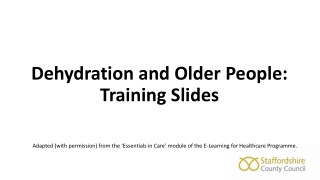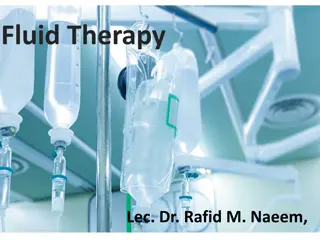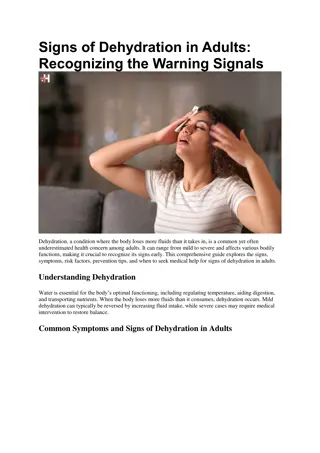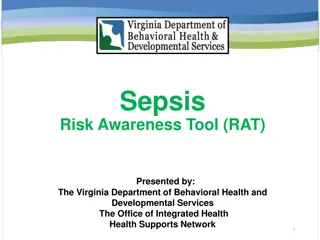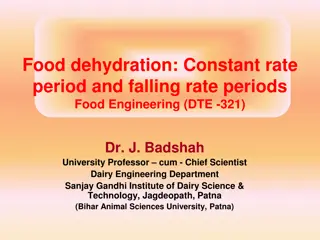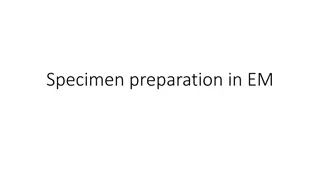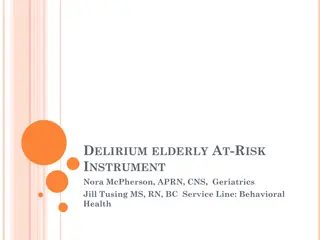Dehydration Risk Awareness Tool (RAT) Overview
The Dehydration Risk Awareness Tool (RAT) presented by The Virginia Department of Behavioral Health and Developmental Services aims to educate DSPs, caregivers, and support coordinators about the importance of recognizing, preventing, and addressing dehydration. The tool covers topics such as signs and symptoms of dehydration, causes, risk factors, interventions, complications, and prevention strategies. It also provides information on electrolytes, dehydration types, and common manifestations.
Download Presentation

Please find below an Image/Link to download the presentation.
The content on the website is provided AS IS for your information and personal use only. It may not be sold, licensed, or shared on other websites without obtaining consent from the author.If you encounter any issues during the download, it is possible that the publisher has removed the file from their server.
You are allowed to download the files provided on this website for personal or commercial use, subject to the condition that they are used lawfully. All files are the property of their respective owners.
The content on the website is provided AS IS for your information and personal use only. It may not be sold, licensed, or shared on other websites without obtaining consent from the author.
E N D
Presentation Transcript
Dehydration Risk Awareness Tool (RAT) Presented by: The Virginia Department of Behavioral Health and Developmental Services The Office of Integrated Health Health Supports Network 1
DSP's and caregivers- you will learn important risk factors associated with dehydration, learn to recognize signs and symptoms, and how to report and document. Who benefits from this training Support Coordinators-you will learn important risk factors associated with dehydration, understand the signs and symptoms that DSP's and caregivers are going to recognize and provide in documentation, and learn diagnosis that may be associated with risk factors.
Objectives 1. Define dehydration. 2. State (4) signs and symptoms of dehydration. 3. Identify (3) causes of dehydration 4. State (3) risk factors for dehydration. 5. List one diagnostic test used by physicians to determine dehydration. 6. Identify (2) interventions used to correct dehydration. 7. List (2) complications caused by unidentified dehydration. 8. State (2) interventions to prevent dehydration.
Electrolytes-are minerals in the body that have an electric charge. They have many important jobs, including helping to Terms & Definitions keep a balance of fluids in the body. Hyponatremia - is a low sodium concentration in the blood. UTI- refers to a urinary tract infection. 4
5 What is Dehydration? Dehydration is condition caused by the loss of too much fluid from the body. It happens when loss of fluids is greater than fluids that are taken in, and the body does not have enough fluids to work properly. There are 2 types of dehydration; water loss dehydration (hyperosmolar, due either to increased sodium or glucose) and salt and water loss dehydration (hyponatremia)(Rolands , 2019).
Signs and Symptoms Feeling thirsty Dry mouth, tongue or skin Poor skin turgor Muscle cramps Constipation Headache Tiredness or lethargy Irritability Decreased urine output or dark, concentrated urine Dizziness or fainting Sweating less than usual Rapid heartbeat or breathing Confusion or disorientation Low blood pressure (orthostatic hypotension) 6
Causes of Dehydration Diarrhea Vomiting Sweating too much Fever Not drinking enough Urinating too much (Can be caused by certain medications and illnesses) 7
Diagnosis & Treatment Diagnosis & Treatment Diagnosis requires an evaluation of the Individual and laboratory testing, clinical assessment, and knowledge of the Individual s medical history (Rolands, 2019). How to treat... Encourage to drink water or other hydrating beverages. IV (intravenous) fluids should begin as soon as possible in a hospital or emergency care setting. IV fluids are usually a saline solution, made of water, sodium, and other electrolytes. By receiving fluids through an IV rather than by drinking them, the body can absorb them more quickly and recover faster (Thomas, et al., 2008). Treating severe dehydration usually requires more than providing water or other beverages. 8
Importance of reporting change Many individuals with intellectual are at risk for dehydration due to being unable to verbalize thirst, being immobile and unable to get a drink when desired and being reliant on others to provide hydration. According to a literature study completed in 2019 , the prevalence of dehydration ranged from 44%-75% for people suffering with difficulty swallowing (dysphagia) (Reber et al, 2019). Although thickening liquids may address the dysphagia issue, thickening agents decrease desire for drinking due to texture and coating in mouth. Individuals with orders for thickened liquids should be monitored to ensure they are receiving adequate hydration (Reber et al., 2019) Any changes or recognition that an individual has signs and symptoms on dehydration should be reported immediately. The individual should be taken to their PCP or an Urgent Care if issue is found on a weekend. Document your findings in daily note and who it was reported to. 10
DSP's connect the dots.... Situation: Sam is attending summer camp. The weather has been wonderful, 80 degrees all week. Sam is so excited that he doesn t like to stop and eat or drink. Sam refuses to wear his hat while participating in the activities. In the afternoon Sam verbalizes that he feels funny. Sam's breathing becomes more rapid and he stops participating. Sam verbalizes he is thirsty and is offered water. Staff notifies the camp nurse. Example only: follow your agency documentation standards. Example of a daily note: 04/13/20 Sam attended summer camp today. Staff encouraged Sam to wear a hat due to the weather, but he refused. Staff encouraged Sam to drink water throughout the day, but Sam refused. Sam ate only 25% of his lunch. At 1:30pm that he felt funny and staff observed him sitting and not participating in the group activities. Staff observed Sam breathing fast. Sam reported he was thirsty and was given water. Staff reported observations to camp nurse. Way to go DSP, you recognized a change! 11
DSP's connect the dots.... Use the RAT tool to help staff be aware of risks and also prompt changes that need to occue with plans and support instructions. The RAT can help providers be proactive. You are the boots on the ground! Based on your daily observations you may recognize a change in statue that would require evaluation. If you notice any of the risk factors listed below for dehydration, report and document it quickly. 12
Case Study Jane lives in a group home with three other individuals. She enjoys going out into the community and loves to eat out. Jane is diagnosed with moderate intellectual disability, Seizures, and Paranoid Schizophrenia. Jane also has frequent urinary tract infections due to becoming dehydration. Jane's urologist has ordered that she consume at least 2000ml daily to help produce frequent urination. This requires staff to prompt and encourage throughout the day. Although Jane likes to be social, sometimes the paranoia keeps her from participating fully in activities. She has auditory hallucinations which make her fearful of others. Jane becomes fearful of food and drink at times. Fearing that staff have not washed their hands when preparing, she will refuse to eat or drink. Jane likes food that is individually wrapped. If she finds spots on the utensils at mealtimes she will refuse to eat or drink. Jane enjoys drinking tea and coffee; however caffeine increases her seizure activity. 13
Apply what you learned State (3) ways you could help Jane meet or exceed her daily recommendation for fluid intake and help her avoid becoming dehydrated. 1.__________________________ 2.__________________________ 3.__________________________ 14
Connect the dots with the RAT Tool... SC's- as you are completing the RAT tool keep in mind there are key diagnoses and situations you need to incorporate in discussion with providers and caregivers to ensure risk factors are being recognized. Individuals who are unable to control their body temperature. Individuals who have fluid restrictions (Polydipsia). Individual's that receive their nutrition and fluids through a gastrostomy tube. Individuals who do not sweat or sweat excessively. Individuals with behaviors that have decrease access to water. RAT TOOL Individuals who receive thickened liquids or refuse to drink liquids. Individual's with Dementia who forget to drink fluids. Older Individuals that have lost their thirst perception. 15
Follow these steps to success Remember! Think about all settings: home, Day Support, Community Engagement Prior to ISP meeting, review discharge summaries, medical reports, and health history for information. Skip Step 2 and go to Section E 16
Follow these steps to success During the ISP meeting ask all participants if they are aware of any risk factors listed in Step 2 17 Dr. Hopewell Nov 15, 20
References Benelam, B., & Wyness, L. (2010). Hydration and health: a review. Nutrition Bulletin, 35(1), 3 25. https://doi.org/10.1111/j.1467-3010.2009.01795.x Chadwick, D. D., Jolliffe, J., Goldbart, J., & Burton, M. H. (2005). Barriers to Caregiver Compliance with Eating and Drinking Recommendations for Adults with Intellectual Disabilities and Dysphagia. Wiley Online Library. https://onlinelibrary.wiley.com/doi/abs/10.1111/j.1468-3148.2005.00250.x. Kunst, K., & University of North Carolina. (March, 2020). The Fatal Four in IDD: Dehydration Signs and Risk Factors. Retrieved from https://www.relias.com/blog/the-fatal-four-how-dangerous-is-dehydration Mayo Clinic. (2016). Dehydration can lead to serious complications. Retrieved from https://newsnetwork.mayoclinic.org/discussion/ dehydration-can-lead-to-serious-complications/ Medline Plus. (2019). Dehydration. Retrieved from https://medlineplus.gov/de hydration.html 19
References Reber, E., Gomes, F., Dahn, I., Vasiloglou, M., & Stanga, Z. (2019). Management of dehydration in persons suffering swallowing difficulties. J Clin Med 8(11), 1923. doi: 10.3390/jcm8111923. Rolands, J. (2019, November). Severe Dehydration: Symptoms, Causes & Treatment. Retrieved from https://www.healthline.com/health/severe-dehydration Thomas, D. R., Cote, T. R., Lawhorne, L., Levenson, S. A., Rubenstein, L. Z., Smith, D. A., Morley, J. E. (2008). Understanding Clinical Dehydration and Its Treatment. Journal of the American Medical Directors Association, 9(5), 292 301. doi: 10.1016/j.jamda.2008.03.006 Peckenpaugh, N. (2010). Nutrition Essentials and Diet Therapy. Saunders, St. Louis, Mossouri. 20


